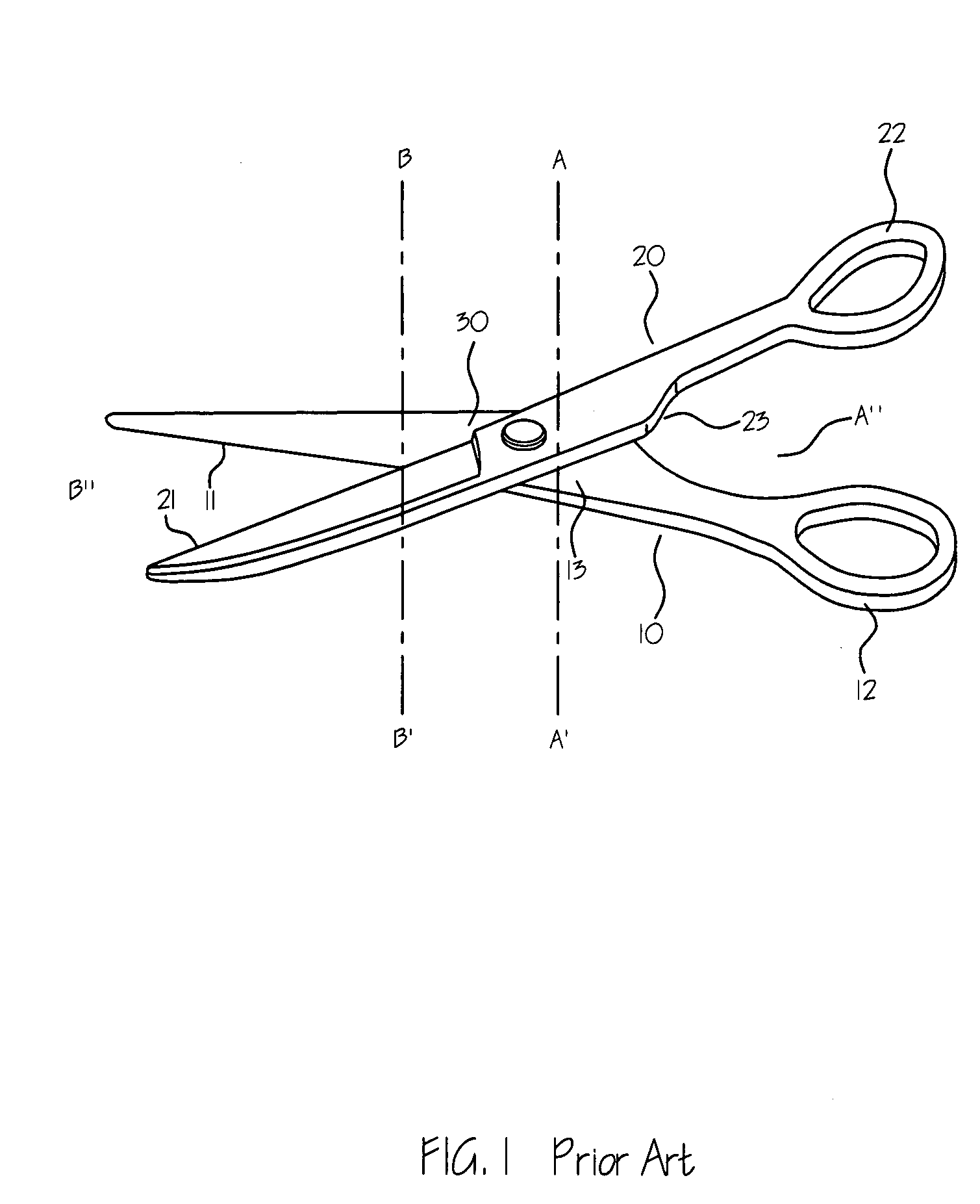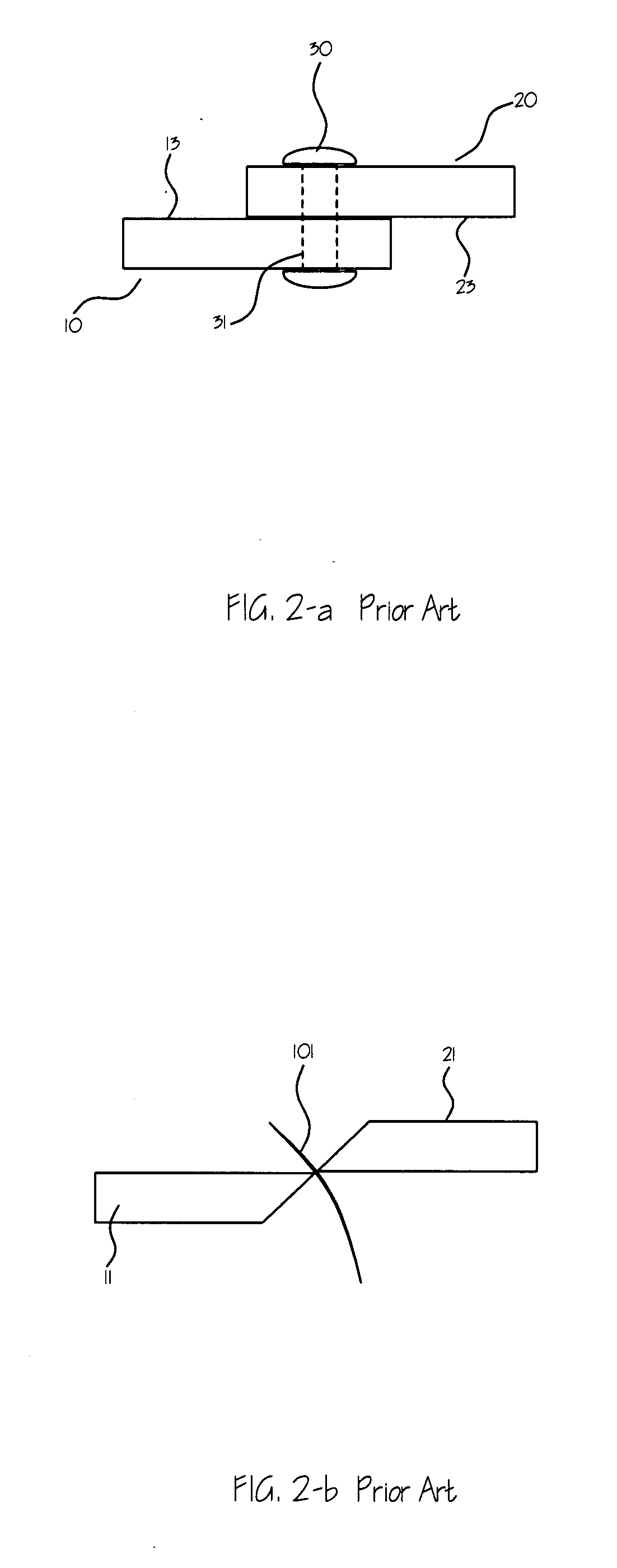Scissors with a blade having a tapered center for hinge
a technology of scissors and hinges, which is applied in the field of scissors equipped with blades, can solve the problems of reducing friction force but not desirable for human hair cutting, and achieve the effects of reducing friction force, reducing friction force, and maximum friction force between the two blades
- Summary
- Abstract
- Description
- Claims
- Application Information
AI Technical Summary
Benefits of technology
Problems solved by technology
Method used
Image
Examples
first embodiment
[0027]FIG. 3 is a perspective view of first embodiment of a scissors (2) according to current application. The scissors (2) according to current application is comprised of a first member (10′) and a second member (20′) pivotally connected by a fastening member (30′). The first member (10′) is comprised of a first blade portion (11′), a first handle portion (13′) and a first ringlet (12′). The second member (20′) is comprised of a second blade portion (21′), a second handle portion (23′) and a second ringlet (22′). A small tapered hump (40) is developed on the surface of the first handle portion (13′), which faces the second handle portion (23′).
[0028]FIG. 4-a is a cross-sectional view of the first embodiment of the scissors (2) according to current application seen along line C-C′ in FIG. 3 when the scissors (2) is fully open seen from the view point C″. When the scissors (2) is fully open, the two members (10′) and (20′) contact horizontally. FIG. 4-b is a side view of the first e...
fourth embodiment
[0037]FIG. 9-b is a cross-sectional view of fourth embodiment of the scissors according to current application seen along line E-E′ in FIG. 3 as the scissors changes position from fully open state to totally closed state, seen from the view point E″. In this case, the angle (104) between the two blades changes from negative to positive as the scissors (2) changes from open state to closed state.
[0038]FIG. 10 is a cross-sectional view of fifth embodiment of the scissors (2) according to current application seen along line C-C′ in FIG. 3 when the scissors is totally closed, seen from the view point C″. In the fifth embodiment, the handle portions (13′) and (23′) of both of the members (10′) and (20′) are convexly carved. In this case, the angle (104) between the two blades also changes from negative to positive as the scissors (2) changes from open state to closed state, as shown in FIG. 9-b.
[0039]FIG. 11 is a cross-sectional view of sixth embodiment of the scissors (2) according to ...
seventh embodiment
[0040]FIG. 12 is a cross-sectional view of seventh embodiment of the scissors according to current application seen along line C-C′ in FIG. 3 when the scissors is totally closed, seen from the view point C″. In the seven embodiment, the handle portions (13′) and (23′) of both of the members (10′) and (20′) are trapezoidally carved. In this case, the angle (104) between the two blades also changes from negative to positive as the scissors (2) changes from open state to closed state, as shown in FIG. 9-b.
[0041]As described above, it is obvious that a person of ordinary skill in the field of this area can easily modify the structure of the handle portion of a scissors according to teaching of the current application.
PUM
 Login to View More
Login to View More Abstract
Description
Claims
Application Information
 Login to View More
Login to View More - R&D
- Intellectual Property
- Life Sciences
- Materials
- Tech Scout
- Unparalleled Data Quality
- Higher Quality Content
- 60% Fewer Hallucinations
Browse by: Latest US Patents, China's latest patents, Technical Efficacy Thesaurus, Application Domain, Technology Topic, Popular Technical Reports.
© 2025 PatSnap. All rights reserved.Legal|Privacy policy|Modern Slavery Act Transparency Statement|Sitemap|About US| Contact US: help@patsnap.com



